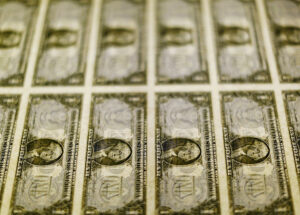PHL dollar reserves inch up to $99.7 billion in July

By Keisha B. Ta-asan, Reporter
THE PHILIPPINES’ dollar reserves edged higher as of end-July, as the value of its gold holdings rose amid an increase in world prices, the central bank said late on Monday.
Preliminary data released by the Bangko Sentral ng Pilipinas (BSP) showed gross international reserves (GIR) inched up by 0.3% to $99.7 billion in July, from the $99.4 billion as of end-June.
Year on year, dollar reserves fell by 0.1%.
This is the highest level of dollar reserves in two months or since the $100.6 billion posted in May.
“The month-on-month increase in the GIR level reflected mainly the upward valuation adjustments in the value of the BSP’s gold holdings due to the increase in the price of gold in the international market,” the central bank said in a statement.
The BSP also attributed the higher dollar reserves to its net foreign exchange operations, income from its investments abroad, and the foreign currency deposits of the National Government.
The end-July reserve level was equivalent to 7.4 months’ worth of imports of goods and payment of services and primary income.
It was about 5.9 times the short-term external debt of the country based on original maturity and 4.1 times based on residual maturity.
A strong reserve buffer protects financial markets from volatility and assures investors and debt watchers that the country can pay its debt in case of an economic downturn.
“The increase in GIR tagged largely to revaluation of gold, which was offset by lower investments, likely due to the movement of global interest rates for the month,” ING Bank N.V. Manila Senior Economist Nicholas Antonio T. Mapa said in an e-mail.
The gold reserve component rose by 2.8% to $10.3 billion as of end-July, from $10.01 billion as of end-June. It was 17.5% higher than $8.76 billion a year earlier.
Rizal Commercial Banking Corp. Chief Economist Michael L. Ricafort said in a note that gold prices in the world market jumped by 2.4% month on month in July.
Meanwhile, gains from investments abroad, which made up the bulk of the GIR, dipped by 0.2% to $83.5 billion from $83.7 billion a month ago and by 0.02% from $83.52 billion a year prior.
Mr. Ricafort said the drop in foreign investments was due to the decline in the global bond markets for a third straight month in July, after the United States raised its debt ceiling.
The central bank also posted higher foreign currency deposits in July, Mr. Mapa said.
Based on BSP data, foreign currency deposits reached $1.3 billion, jumping by 8.3% from the $1.2 billion as of end-June. However, this fell by 58% from the $3.1-billion level as of end-July 2022.
Net international reserves edged higher by 0.3% to $99.7 billion at the end of July from $99.4 billion in the previous month, the BSP said.
Net international reserves are the difference between the central bank’s reserve assets and reserve liabilities such as short-term foreign debt, and credit and loans from the International Monetary Fund (IMF).
Special drawing rights, or the amount the country can tap from the IMF, was unchanged at $3.76 billion for the second straight month. Year on year, it inched up by 0.8% from $3.73 billion in 2022.
Buffers kept with the IMF rose by 0.9% to $801.8 million from $794.6 million as of end-June and by 6.4% from $753.5 million in the same period in 2022.
“The BSP continues to shore up its reserves which will be helpful if the time comes where the peso will experience unusual volatility, especially given the narrower gap between Philippine and US interest rates,” China Banking Corp. Chief Economist Domini S. Velasquez said in a Viber message.
At its July meeting, the US Federal Reserve raised its own policy target range by 25 basis points (bps) to 5.25-5.5%, the highest in more than two decades. The Fed has hiked 550 bps since March last year.
In June, the BSP extended its policy pause for a second straight meeting and kept the key rate at 6.25%. Since May 2022, the BSP has raised borrowing costs by 425 bps.
According to Mr. Mapa, the country’s dollar reserves remain more than adequate as they were more than four times short-term obligations based on residual maturity.
“Concerns of GIR depletion can be allayed for now given the steady stream of foreign currency via remittances, which have shown resilience even in a time of global lockdowns,” he said.
He was referring to concerns over the BSP’s use of dollar reserves to mitigate the volatility in the foreign exchange market after the US Federal Reserve tightened policy rates in July.
“Moving forward, if the peso depreciates rapidly and excessively, higher reserves will give the BSP sufficient ammunition to defend the peso,” Ms. Velasquez said.
“Our current forecast is that the (foreign exchange) will remain relatively stable and that the peso will be stronger compared with the P59 levels we saw last year,” she said.
The peso hit its lowest level of P59 against the dollar in October last year, amid the aggressive tightening by the US Federal Reserve.
“A country’s GIR represents the first line of defense for the currency, but it is by no means the last as the BSP has several standing facilities available to tap in case dollar liquidity does indeed become stretched,” Mr. Mapa said.
He said that none of these facilities have been used by the central bank, reflecting the resiliency of the country’s external position.
“With regard to inflows, we think the BSP will continue to have steady sources of foreign reserves due to robust growth of BPOs (business process outsourcing), remittances, and tourism,” Ms. Velasquez added.
The BSP projects the country’s dollar reserves to hit $100 billion this year.




